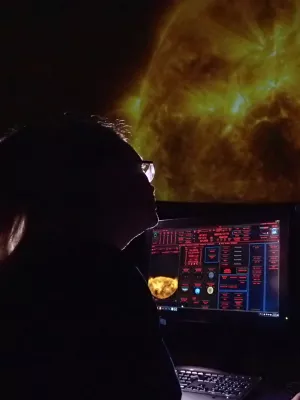
Anna Arnadottir
Research engineer

The ability of intermediate-band Stromgren photometry to correctly identify dwarf, subgiant, and giant stars and provide stellar metallicities and surface gravities
Author
Summary, in English
Context. Several large scale photometric and spectroscopic surveys are being undertaken to provide a more detailed picture of the Milky Way. Given the necessity of generalisation in the determination of, e.g., stellar parameters when tens and hundred of thousands of stars are considered it remains important to provide independent, detailed studies to verify the methods used in the surveys. Aims. Our first aim is to critically evaluate available calibrations for deriving [M/H] from Stromgren photometry. Secondly, we develop the standard sequences for dwarf stars to reflect their inherent metallicity dependence. Finally, we test how well metallicities derived from ugriz photometry reproduce metallicities derived from the well-tested system of Stromgren photometry. Methods. We evaluate available metallicity calibrations based on Stromgren uvby photometry for dwarf stars using a catalogue of stars with both uvby photometry and spectroscopically determined iron abundances ([Fe/H]). The catalogue was created for this project. Using this catalogue, we also evaluate available calibrations that determine log g. A larger catalogue, in which metallicity is determined directly from uvby photometry, is used to trace metallicity-dependent standard sequences for dwarf stars. We also perform comparisons, for both dwarf and giant stars, of metallicities derived from ugriz photometry with metallicities derived from Stromgren photometry. Results. We provide a homogenised catalogue of 451 dwarf stars with 0.3 < (b - y)(0) < 1.0. All stars in the catalogue have uvby photometry and [Fe/H] determined from spectra with high resolution and high signal-to-noise ratios (S/N). Using this catalogue, we test how well various photometric metallicity calibrations reproduce the spectroscopically determined [Fe/H]. Using the preferred metallicity calibration for dwarf stars, we derive new standard sequences in the c(1,0) versus (b - y)(0) plane and in the c(1,0) versus (v - y)(0) plane for dwarf stars with 0.40 < (b - y)(0) < 0.95 and 1.10 < (v - y)(0) < 2.38. Conclusions. We recommend the calibrations of Ramirez & Melendez (2005) in deriving metallicities from Stromgren photometry and find that intermediate band photometry, such as Stromgren photometry, more accurately than broad band photometry reproduces spectroscopically determined [Fe/H]. Stromgren photometry is also better at differentiating between dwarf and giant stars. We conclude that additional investigations of the differences between metallicities derived from ugriz photometry and intermediate-band photometry, such as Stromgren photometry, are required.
Department/s
- Lund Observatory - Undergoing reorganization
Publishing year
2010
Language
English
Publication/Series
Astronomy & Astrophysics
Volume
521
Document type
Journal article
Publisher
EDP Sciences
Topic
- Astronomy, Astrophysics and Cosmology
Keywords
- Galaxy: stellar content
- solar neighborhood
- stars: abundances
- stars: fundamental parameters
Status
Published
ISBN/ISSN/Other
- ISSN: 0004-6361

